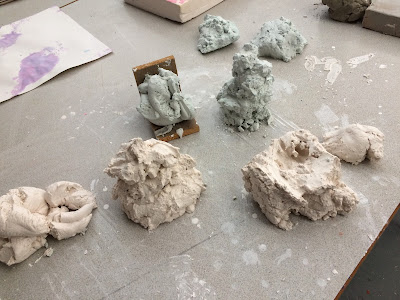Working with a new material
The type of plaster I usually use is Fine Casting Plaster, but as it is ending the end of the educational year, supplies have become more limited.
Instead, I chose to experiment with pottery plaster. I was told that the plaster had gone off and was therefore unusable, but to experiment with it anyway because it was unclear as to whether or not the plaster could be used.
This kind of plaster is mixed the same way as Fine Casting wherein you combine water and plaster ad then start mixing, unlike One Coat plaster, which requires that you mix to consistency (mix while adding the plaster to the water)
Instead, I chose to experiment with pottery plaster. I was told that the plaster had gone off and was therefore unusable, but to experiment with it anyway because it was unclear as to whether or not the plaster could be used.
This kind of plaster is mixed the same way as Fine Casting wherein you combine water and plaster ad then start mixing, unlike One Coat plaster, which requires that you mix to consistency (mix while adding the plaster to the water)
There aren't many noticeable differences between the two plasters, but Pottery Plaster had a more gritty feeling to it as you mix it, but other than that, they are similar in both mixing time and setting time.
Unfortunately, because we were unsure as to whether or not this plaster was any good, I was experimenting with the proportions needed to make the mix. The first mix I did, I added ink, which will have affected how much plaster is needed for the mix to work, as I found out when it wasn't thickening. Once I added some mroe plaster, however, the mix thickened up almost instantly, so I had thought that I had added too much plaster to the mix, and by adding too much plaster to a mix, it means that it doesn't quite set.
The next batch of plaster I made without ink, but tried piping through a glove to see if it would set. I noticed when I was piping it that it doesn't have the flexibility that Fine Casting plaster does, so rather than being able to make smooth curves in plaster, it splits and breaks.
After this, I tried various different mixes using different amounts of plaster, but never different amounts of water. It is difficult to say which worked the best, as none of the plaster set, however, interestingly enough, the first batch I made with the added ink that I had thought I had oversaturated turned out to set the best, even if it hasn't set fully.
After this, I tried various different mixes using different amounts of plaster, but never different amounts of water. It is difficult to say which worked the best, as none of the plaster set, however, interestingly enough, the first batch I made with the added ink that I had thought I had oversaturated turned out to set the best, even if it hasn't set fully.
Also, the ink in the plaster that set the best had started to rise to the surface within matter of days, despite the fact that the plaster still hadn't set.
After an experiment using organic materials, wherein I made natural pigments using plant pulp, I decided to see what would happen, or if anything would happen, if I left the unset plaster in different environments.
I places three of the plaster lumps outside in different places; one was raised and wasn't touching the ground, which one was under tree, and the other in a flowerbed. My reasoning to choosing these different locations is that each is affected different by the weather, particularly by rain and sunlight.The plaster that is raised above the ground is highly exposed to rain and sunlight as well as other elements, but because it isn't touching the ground, it is more likely to dry. The plaster set under a tree is constantly in the shade, and if it rains, it is in an area that is more likely to remain damp. The lump of plaster in the flowerbed is exposed to sunlight, but is also on a surface that absorbs water.
I decided to return to them in a weeks time to see what changes have occurred. This will also determine whether or not I choose to use the Pottery Plaster, and will also determine how I can experiment with materials that are structurally unsound.







No comments:
Post a Comment